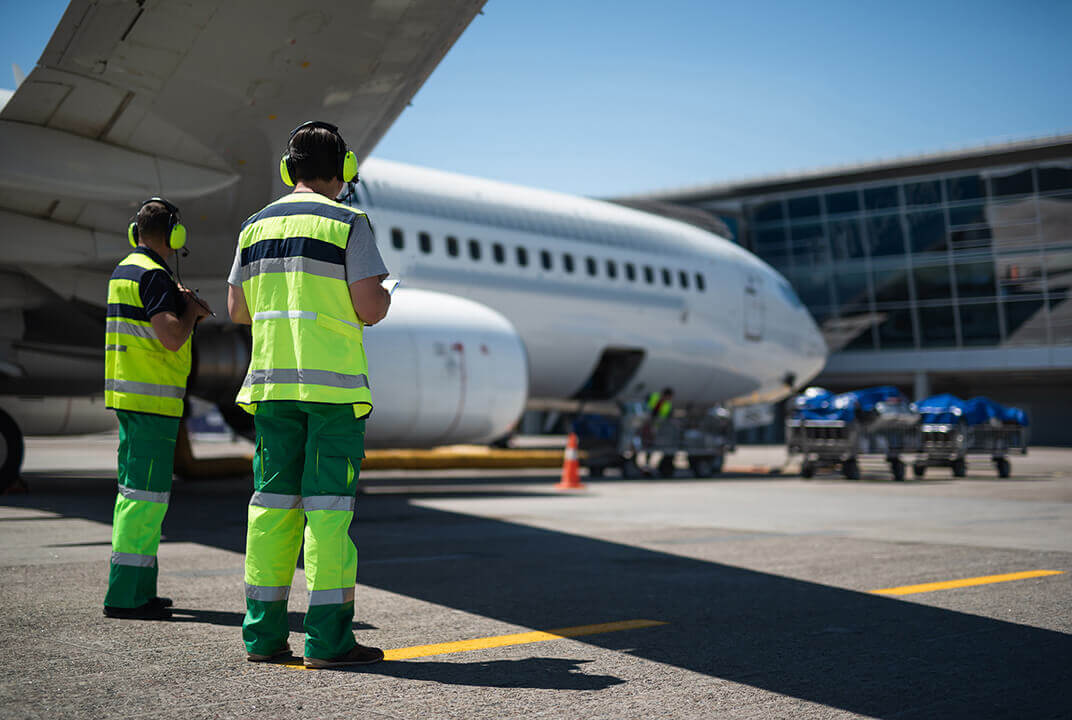Technology innovations to revolutionise aviation unveiled in new Cranfield University and Inmarsat report
Aviation
Research explores 21 cutting-edge concepts, such as conscious aircraft, trajectory based operations, artificial intelligence and digital trust technology, set to define future of aviation
With a rebound in air travel now underway, a new report published today by Cranfield University and Inmarsat highlights the critical role that digital connectivity will play in accelerating aviation’s long-term recovery. Titled ‘Why the future of aviation starts with connectivity’, the study offers insights and direction for key aviation stakeholders and governments as they reconsider their priorities for the industry’s future. This will be fuelled largely by a monumental shift in passenger behaviour and expectations following the pandemic, as well as increased consumer awareness of their impact on the climate.
The report highlights a number of transformative changes ahead for the aviation industry and examines how airlines can take advantage of the enormous opportunities created as a result.
As part of their research, experts from Cranfield University have developed a Digital Connectivity Timeline, which outlines when 21 of the industry’s most critical technological innovations can be expected to reach adoption. It focuses on three distinct timeframes: five years (technologies at advanced stages of development and in some cases are being piloted by organisations ahead of market adoption), between five to ten years (technologies under early development with potential to be trialled in some sectors), and beyond the next decade (concepts under consideration for product or service offering development).
These technologies will enable a range of innovative concepts to make their way onto aircraft and airspace, helping to define the future of aviation while leading to important step changes in passenger experience and sustainability efforts. Amongst the concepts explored are:
- How the ‘Conscious Aircraft’ uses sensing and communication technologies to create an integrated aircraft health, maintenance, and performance management system that is capable of a fully aware state, with the ability to either take or suggest appropriate action. For example, it can accurately predict the health of aircraft components and automatically reconfigure them to optimise their lifecycle. In addition, it can sense changes in the external environment, like weather or a volcanic ash cloud. With the reduced need for planned maintenance, as well as anticipating the potential for component failures, maintenance costs would be cut by an estimated 30%.
- How the ‘Connected Journey’ will enhance a passenger’s experience with more efficient and personalised wayfinding through airports, more intelligent and response baggage tracking, real-time updates on flight disruptions, and seamless high-speed inflight connectivity.
- How Trajectory Based Operations are a critical step towards the future management of air traffic, allowing more efficient traffic sequencing and routine deployment of so-called fuel efficient ‘green descents’ to airport terminal areas.
- How Artificial Intelligence (AI) and digital trust technologies have enormous potential to be applied across all aviation sectors. AI can provide intelligent advice on aircraft management issues and make informed decisions under pressure – when there is the need to make a diversion, for example – with camera-based traffic detection, or helping crew to anticipate and prevent critical situations. Machine Learning (ML) can improve accuracy of any application involving optimisation, from sensor calibration to fuel tank checks to icing detection.
The report also examines how the complexity and interoperability of future ecosystems are significant challenges for technology providers, regulators and airlines alike.
Philippe Carette, President of Inmarsat Aviation, said: “Our new report with Cranfield University has considered how the role of digital connectivity, in all its forms, can enable and accelerate meeting the rapidly changing needs of air travellers and of the aviation sector itself. It has identified specific challenges and opportunities that, if addressed, will have a direct beneficial effect on the sector’s resilience, its contribution to reducing climate change, and to new customer service offerings that will enhance passengers’ willingness to travel in the post-pandemic world.
“Harnessing the technological innovations explored in this report will be nothing short of revolutionary for our industry, and at Inmarsat, we can’t wait to play our part in bringing them to life through our global connectivity and world-leading ORCHESTRA network of networks.”
Professor Karen Holford CBE FREng, Chief Executive and Vice-Chancellor, Cranfield University: “While this is a time of great challenge for the aviation industry, reports such as this one show the path that technology can put us on towards a brighter and more sustainable future. ‘Digital aviation’ and the foundation of connectivity needs to stop being just a concept of tomorrow, and become the reality of today. This report sets out the many technological possibilities and what can be achieved in the short to medium term. What is needed now is for us all to redouble our efforts to make them a reality.”
The full report, executive summary and Digital Connectivity Timeline are available here.
Inmarsat, the world leader in global, mobile satellite communications, recently unveiled plans for ORCHESTRA, the communications network of the future, which will bring existing geosynchronous (GEO) satellites together with low earth orbit satellites (LEO) and terrestrial 5G to form an integrated, high-performance solution, unmatched by any existing or planned competitor offering. ORCHESTRA allows capacity to be boosted in high-density areas such as at airports, eliminating congested network ‘hot spots’ and ensuring the connectivity needs of aviation customers continue to be met well into the future, with capacity scaled directly to match their requirements.
Further information
About Inmarsat
Inmarsat is the world leader in global, mobile satellite communications. It owns and operates the world’s most diverse global portfolio of mobile telecommunications satellite networks, and holds a multi-layered, global spectrum portfolio, covering L-band, Ka-band and S-band, enabling unparalleled breadth and diversity in the solutions it provides. Inmarsat’s long-established global distribution network includes not only the world’s leading channel partners but also its own strong direct retail capabilities, enabling end to end customer service assurance.
The company has an unrivalled track record of operating the world’s most reliable global mobile satellite telecommunications networks, sustaining business and mission critical safety & operational applications for more than 40 years. It is also a major driving force behind technological innovation in mobile satellite communications, sustaining its leadership through a substantial investment and a powerful network of technology and manufacturing partners.
Inmarsat operates across a diversified portfolio of sectors with the financial resources to fund its business strategy and holds leading positions in the Maritime, Government, Aviation and Enterprise satcoms markets, operating consistently as a trusted, responsive and high-quality partner to its customers across the globe.
For further information, follow us: Twitter | LinkedIn | Facebook | YouTube | Instagram.
Contacts for media enquiries
Jonathan Sinnatt/Matthew Knowles
Corporate Communications
Tel: +44 (0) 7889 605 272 / +44 (0) 7725 475 507
press@inmarsat.com
Alex Holt
Marketing Business Partner, Inmarsat Aviation
Tel: +44 (0)20 7728 1000
alex.holt@inmarsat.com
About Cranfield University
Cranfield is a specialist postgraduate university that is a global leader for education and transformational research in technology and management.
Cranfield is the number one university in Europe for aerospace. We are one of the few universities in the world to have its own airport. Our history and heritage in aircraft research and design over the last 70 years is extending into the future with new capabilities in aircraft electrification, unmanned aerial vehicle technology and urban mobility.
As the UK's most business-engaged University, we have long-term relationships and close commercial partnerships with many companies in the sector including Airbus, BAE Systems, Boeing and Rolls-Royce.
Our education, research and consultancy is enhanced by our world-class facilities including the National Flying Laboratory Centre – a unique national asset which provides a hands-on, flying experience – along with flight deck simulators and industrial-scale gas turbine engine test facilities used for performance and diagnostic studies. The Aerospace Integration Research Centre, a £35 million innovative centre built in partnership with Airbus and Rolls-Royce, fosters collaboration between industry and academia, and a new £65 million Digital Aviation Research and Technology Centre is spearheading the UK’s research into digital aviation technology.
Our global research airport offers a unique environment for transformational research. Interconnectivity between our facilities and across academic disciplines is enabling us to rethink the airports, airlines, airspace management and aircraft of the future in a holistic way. Barclay’s first Eagle Lab dedicated to aviation technology and supporting start-ups and SMEs opened on our campus in 2019.
Our National Beyond visual line of sight Experimentation Corridor – created with partners Blue Bear Research Systems, Thales and Vodafone – provides a safe, managed environment for drone and unmanned aircraft experimentation.
Cranfield also has a long history in space systems, having undertaken space studies since the 1960s.
Notable Cranfield alumni include Warren East, CEO of Rolls-Royce plc and Ralph Hooper, who attended the College of Aeronautics at Cranfield in 1946 and went on to become one of the UK’s most important post-war aircraft designers, creating the Hawker Harrier jump jet.

